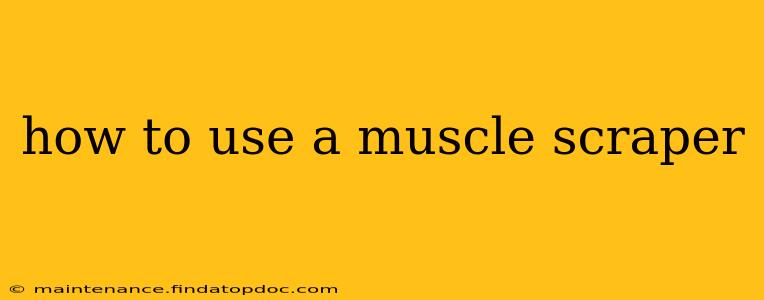Muscle scrapers, also known as Iaido scrapers or gua sha tools for muscles, are increasingly popular for self-massage and addressing muscle soreness, tightness, and inflammation. While they offer potential benefits, it's crucial to understand the correct technique to avoid injury. This comprehensive guide will walk you through how to use a muscle scraper safely and effectively.
What is a Muscle Scraper and What are its Benefits?
A muscle scraper is a tool, typically made of smooth, rounded materials like stainless steel, plastic, or wood, used to gently scrape the skin over muscles. The action is believed to improve blood flow, reduce inflammation, and promote tissue repair. Potential benefits include:
- Reduced Muscle Soreness: Scraping can alleviate the pain and stiffness associated with delayed-onset muscle soreness (DOMS).
- Improved Range of Motion: By loosening tight muscles, scrapers can help increase flexibility and mobility.
- Enhanced Blood Circulation: The scraping action stimulates blood flow to the treated area, potentially aiding in the removal of metabolic waste products.
- Reduced Inflammation: Some users report a reduction in inflammation and swelling.
How to Use a Muscle Scraper: A Step-by-Step Guide
Before you begin, it's essential to use a lubricant such as massage oil, lotion, or even a thin layer of petroleum jelly. This minimizes friction and reduces the risk of skin irritation.
Step 1: Preparation
- Clean the area: Cleanse the area of your skin you intend to scrape.
- Choose a lubricant: Apply a generous amount of lubricant to the skin. This will make the scraping process smoother and prevent any discomfort.
- Choose your pressure: Start with light pressure. You should feel a gentle scraping sensation, not pain. Pressure can be gradually increased, but only if comfortable.
- Find the right angle: Hold the tool at a shallow angle (around 15-30 degrees) to the skin. Avoid pressing straight down.
Step 2: The Scraping Technique
- Long, smooth strokes: Use long, smooth strokes in the direction of your heart. For example, if scraping your leg, move the tool towards your heart.
- Overlap strokes: Slightly overlap each stroke to ensure full coverage of the muscle.
- Avoid bony areas: Avoid scraping directly over bony areas, joints, or sensitive areas like the eyes.
- Listen to your body: Stop if you experience any sharp pain or discomfort.
Step 3: Post-Scraping Care
- Hydrate: Drink plenty of water to help flush out toxins.
- Monitor your skin: Watch for any signs of irritation or bruising.
What Areas Can You Use a Muscle Scraper On?
Muscle scrapers can be used on various muscle groups, including:
- Back: Effective for relieving tension and stiffness.
- Legs: Can help with tight hamstrings, quads, and calves.
- Arms: Useful for addressing stiffness in biceps, triceps, and forearms.
- Neck and Shoulders: Can help alleviate tension headaches and neck pain (use extra caution in this area).
How Often Should You Use a Muscle Scraper?
It's generally recommended to start with one or two sessions per week. As you become more comfortable, you can increase the frequency. Always listen to your body and adjust the frequency as needed. Avoid using a muscle scraper daily, unless advised by a healthcare professional.
What are the Potential Risks and Side Effects of Using a Muscle Scraper?
While generally safe, muscle scraping can cause:
- Skin irritation or bruising: This is more likely if too much pressure is used or if the skin is not properly lubricated.
- Aggravation of existing conditions: Individuals with certain skin conditions or bleeding disorders should consult their physician before using a muscle scraper.
Is it Safe for Everyone to Use a Muscle Scraper?
No, muscle scraping is not suitable for everyone. Consult your doctor or physical therapist before using a muscle scraper if you:
- Have any skin conditions.
- Have bleeding disorders.
- Are pregnant.
- Have recently undergone surgery.
- Have any other health conditions.
What is the difference between gua sha and muscle scraping?
While often used interchangeably, gua sha and muscle scraping share similarities but differ in application and intent. Gua sha typically focuses on lymphatic drainage and superficial fascial release, often using a more gentle approach and broader strokes across the skin. Muscle scraping is a more targeted technique aimed at deep muscle tissue release, addressing specific muscle tension or soreness with stronger, more focused strokes.
This guide provides a general overview of using a muscle scraper. Always prioritize safety and consult a healthcare professional if you have any concerns. Remember, this information is for educational purposes and should not be considered medical advice.
